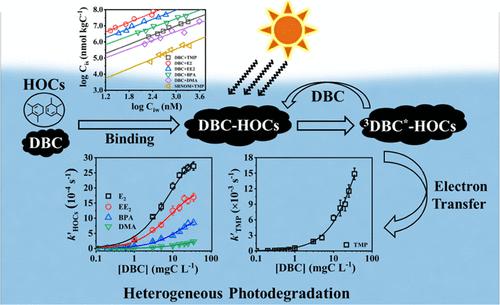当前位置:
X-MOL 学术
›
Environ. Sci. Technol.
›
论文详情
Our official English website, www.x-mol.net, welcomes your
feedback! (Note: you will need to create a separate account there.)
Microheterogeneous Triplet Oxidation of Hydrophobic Organic Contaminants in Dissolved Black Carbon Solutions under Simulated Solar Irradiation
Environmental Science & Technology ( IF 10.8 ) Pub Date : 2022-09-29 , DOI: 10.1021/acs.est.2c06395 Hui Wang 1, 2 , Mengqi Han 3 , Mei Wang 3 , Huaxi Zhou 4
Environmental Science & Technology ( IF 10.8 ) Pub Date : 2022-09-29 , DOI: 10.1021/acs.est.2c06395 Hui Wang 1, 2 , Mengqi Han 3 , Mei Wang 3 , Huaxi Zhou 4
Affiliation

|
Dissolved black carbon (DBC) is proven to accelerate the triplet-mediated photodegradation of hydrophobic organic contaminants (HOCs). However, its photosensitization mechanisms are not clear. In this study, five HOCs including 2,4,6-trimethylphenol, N,N-dimethylaniline, 17β-estradiol, 17α-ethinylestradiol, and bisphenol A were selected as model compounds to explore the triplet-mediated phototransformation of HOCs in illuminated DBC solutions. All five HOCs presented high organic carbon-water partition coefficient (KOC) values in DBC solutions, indicating the strong sorption capacity of DBC for HOCs. When reaching sorption equilibrium, the apparent pseudo-first-order rate constants of HOCs vs log[DBC] were well fitted with a sorption-enhanced phototransformation model (R2 > 0.98). Using the sorption-enhanced phototransformation model, the degradation rates of HOCs determined at intra-DBC (kDBC,HOCs′) were 1–2 orders of magnitude higher than those observed in aqueous bulk solution (kHOCsaq). Moreover, typical triplet quenchers (2,4,6-trimethylphenol and oxygen) exhibited a microheterogeneous quenching effect on the triplet-mediated photodegradation of 17β-estradiol. Therefore, our results suggested that HOCs underwent a microheterogeneous photooxidative degradation process in DBC solutions. Furthermore, a sorption-enhanced phototransformation mechanism was proposed to elucidate the microheterogeneous photooxidative behavior of HOCs in DBC solutions. This study provides new insights into the fate and transport of HOCs in aquatic environments.
中文翻译:

模拟太阳辐照下溶解黑碳溶液中疏水性有机污染物的微非均相三重态氧化
溶解黑碳 (DBC) 已被证明可加速疏水性有机污染物 (HOC) 三重态介导的光降解。然而,其光敏机制尚不清楚。在本研究中,选择了 2,4,6-三甲基苯酚、N、N-二甲基苯胺、17β-雌二醇、17α-炔雌醇和双酚 A 等五种 HOC 作为模型化合物,以探索 HOC 在光照 DBC 溶液中的三重介导光转化. 所有五种 HOC 均呈现出较高的有机碳-水分配系数 ( K OC) 在 DBC 溶液中的值,表明 DBC 对 HOC 具有很强的吸附能力。当达到吸附平衡时,HOCs 与 log[DBC] 的表观准一级速率常数很好地拟合了吸附增强的光转化模型 ( R 2 > 0.98)。使用吸附增强的光转化模型,在 DBC 内测定的 HOCs 的降解速率(k DBC,HOCs ')比在水溶液中观察到的高 1-2 个数量级(k HOCs aq)。此外,典型的三重态猝灭剂(2,4,6-三甲基苯酚和氧)对三重态介导的 17β-雌二醇光降解表现出微非均相猝灭效应。因此,我们的结果表明,HOCs 在 DBC 溶液中经历了微不均匀的光氧化降解过程。此外,提出了一种吸附增强的光转化机制来阐明 HOC 在 DBC 溶液中的微非均相光氧化行为。这项研究为水生环境中 HOCs 的命运和运输提供了新的见解。
更新日期:2022-09-29
中文翻译:

模拟太阳辐照下溶解黑碳溶液中疏水性有机污染物的微非均相三重态氧化
溶解黑碳 (DBC) 已被证明可加速疏水性有机污染物 (HOC) 三重态介导的光降解。然而,其光敏机制尚不清楚。在本研究中,选择了 2,4,6-三甲基苯酚、N、N-二甲基苯胺、17β-雌二醇、17α-炔雌醇和双酚 A 等五种 HOC 作为模型化合物,以探索 HOC 在光照 DBC 溶液中的三重介导光转化. 所有五种 HOC 均呈现出较高的有机碳-水分配系数 ( K OC) 在 DBC 溶液中的值,表明 DBC 对 HOC 具有很强的吸附能力。当达到吸附平衡时,HOCs 与 log[DBC] 的表观准一级速率常数很好地拟合了吸附增强的光转化模型 ( R 2 > 0.98)。使用吸附增强的光转化模型,在 DBC 内测定的 HOCs 的降解速率(k DBC,HOCs ')比在水溶液中观察到的高 1-2 个数量级(k HOCs aq)。此外,典型的三重态猝灭剂(2,4,6-三甲基苯酚和氧)对三重态介导的 17β-雌二醇光降解表现出微非均相猝灭效应。因此,我们的结果表明,HOCs 在 DBC 溶液中经历了微不均匀的光氧化降解过程。此外,提出了一种吸附增强的光转化机制来阐明 HOC 在 DBC 溶液中的微非均相光氧化行为。这项研究为水生环境中 HOCs 的命运和运输提供了新的见解。











































 京公网安备 11010802027423号
京公网安备 11010802027423号